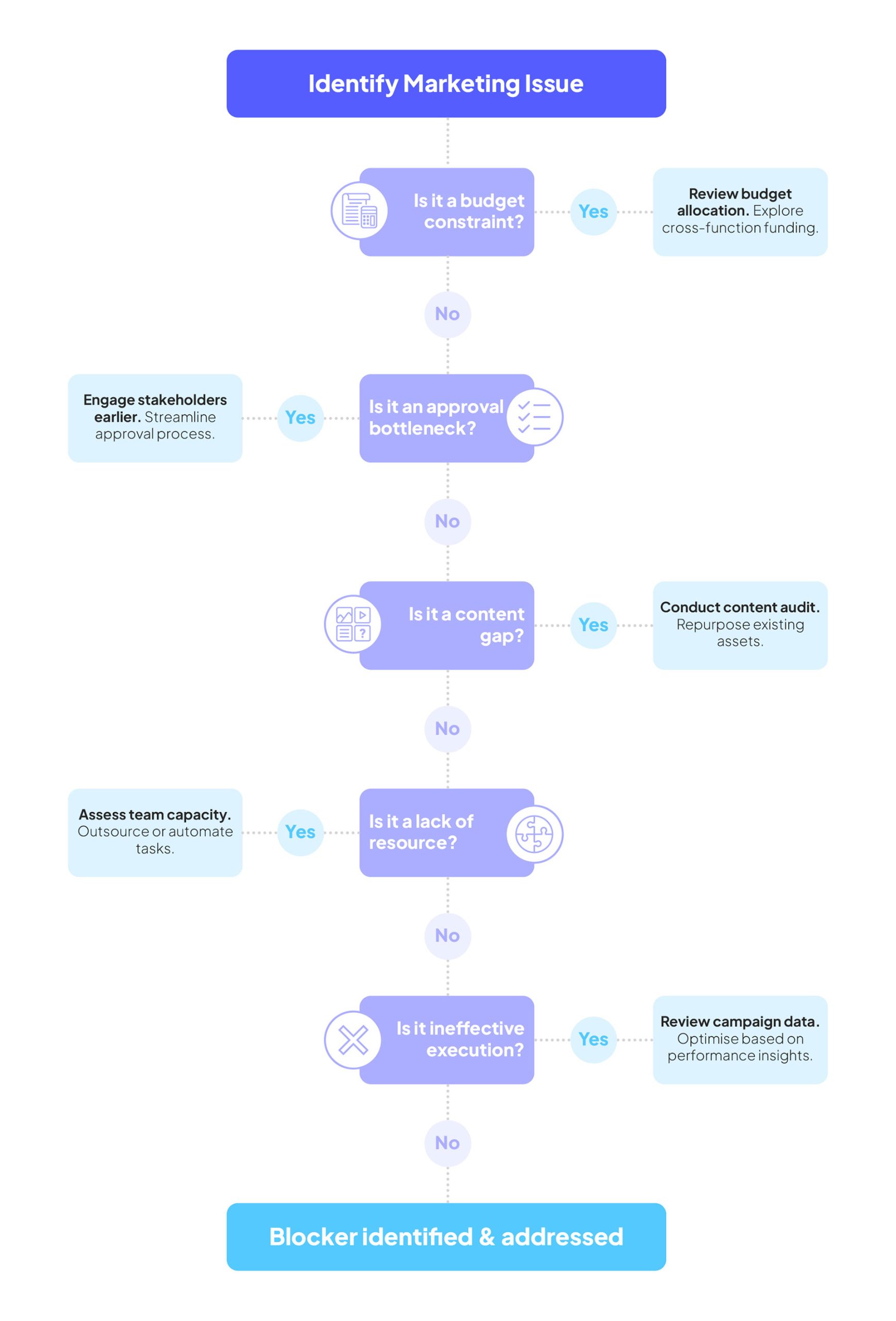Marketing can’t afford to be slowed down by inefficiencies, especially when teams are under pressure to deliver more with less. Identifying and removing blockers isn’t just about smoother workflows – it’s also about protecting growth potential.
At times, we’ve all probably felt that the internal blockers we face are unique to our own industry, organisation or department. No matter how frustrating they can be, in reality, there is a lot of shared frustration wherever you look.
We work across tech (cybersecurity, cloud and data, to be exact) and telecoms, and we come across the same challenges quite often – complex sales cycles, strict compliance regulations, and the need for deeply technical content can create roadblocks that slow down momentum. But the key to marketing success isn’t just pushing harder… it’s about working smarter.
Understanding what they are and having a plan on how to deal with them can actually accelerate results.
1. Diagnose your blockers with a structured approach
Before fixing anything, you need to pinpoint the root cause. A structured framework (such as a simple flowchart) can help map out common blockers like budget constraints, approval bottlenecks, or content gaps. By visualising the roadblocks, you can quickly determine whether the issue is an internal misalignment, a lack of resources, or ineffective campaign execution.
Action points:
- Create a flowchart or checklist to identify recurring blockers in your marketing workflows
- Hold regular team retrospectives to discuss common challenges and refine processes
- Engage key stakeholders early in campaign planning to prevent approval delays

2. Unlock hidden value in existing content
We’ve all been there – when we look at running a new campaign, we see all of that content and think, ‘how on earth am I going to create all of that?’ Teams often feel the pressure to start from scratch, but a smarter approach is to conduct a content audit – something that your colleagues will also thank you for in the long-run.
Chances are, you already have valuable assets that can be repurposed across multiple formats. A technical whitepaper can be turned into blog posts, social snippets, an infographic, or even a webinar. This not only saves time and budget but also ensures your messaging stays consistent across all channels.
Consider developing a content matrix where you think cross-channel and format. For instance, if you are running a webinar, have a list of other content types and then select each format that you feel could accompany and support the core piece of webinar content. It’s always quicker and cheaper to create more content at the same time. This type of thinking will give you more useful content to use; increasing the effectiveness of your campaigns.
And think outside of your current remit. Let other colleagues and teams know what you are doing. Another department might already be creating just what you need, or may be looking for the same thing you are about to create. This can result in pooled resources and budgets, and creates synergy across campaigns.
Action points:
- Speak to your colleagues to see if something already exists or is required
- Conduct a content audit to assess what can be repurposed or refreshed
- Develop a content repurposing framework (e.g., blog to social post, webinar to eBook)
- Use analytics to identify high-performing content that can be leveraged further
3. Connect campaign activity to business impact
One of the biggest blockers is the misalignment between marketing activity and business objectives. Define key performance indicators (KPIs) that matter to stakeholders, whether it’s pipeline acceleration, lead conversion rates, or customer retention. Then, ensure your campaigns provide the right level of visibility. Highlighting small wins and demonstrating progress in measurable ways will help secure ongoing buy-in from leadership.
Action points:
- Work with sales and leadership to define meaningful KPIs that align with revenue goals and ladder up to bigger departmental or business objectives
- Set up dashboards to track and communicate performance using the right data for different internal personas
- Provide regular reports with actionable insights, not just data dumps
4. Find hidden budget through cross-functional collaboration
Marketing budgets are being squeezed right now, but that doesn’t mean there’s no room to expand. Consider how your campaigns could support multiple teams such as sales enablement, product marketing, or customer success. When initiatives are designed to benefit more than one function, you can often unlock additional budget from other departments. A campaign positioned as a revenue enabler, not just a brand-building exercise, is far more likely to gain internal traction!
Action points:
- Identify overlapping goals between marketing, sales, and customer success
- Where relevant; pitch marketing initiatives as revenue-generating opportunities to secure additional budget
- Create co-branded content that supports multiple departments, maximising impact
5. Leverage partnerships & marketing development funds (MDF)
No matter which industry you work in, partnerships play a crucial role in marketing success. Many vendors and carriers offer marketing development funds (MDF) to help drive demand generation. Yet, these funds are often underutilised due to complex application processes, lack of resources to use them effectively or even knowing the MDF is available. By proactively tapping into MDF opportunities, co-marketing initiatives, and joint campaigns, you can significantly expand your resources, as well as amplify your reach.
Most businesses have partners themselves. These partners are usually hungry for content and are always looking for co-author opportunities. By speaking to your channel team, understanding your partner pool, a suitable partner you can go to market with can usually be found. This could see the partner come with budget, or even create it for you if you can bring the expertise. This could give you and the partner unique content to go to market with and if done together, can increase your reach.
Action points:
- Research MDF opportunities offered by key partners, carriers and vendors
- Develop joint marketing proposals that highlight mutual benefits
- Streamline the MDF application process within your organisation to ensure funds are utilised efficiently
- Speak with your channel team to understand what opportunities may be available
Final Thoughts
Marketing in highly technical industries like yours, doesn’t need to feel like an uphill battle. By identifying blockers, maximising existing content, aligning execution with business goals, thinking cross-functionally, and leveraging strategic partnerships, you can build a more efficient and scalable marketing strategy. The key is to work with, not against, the challenges, turning obstacles into opportunities for growth.
Need help uncovering your blockers and accelerating your marketing momentum? Let’s chat.

Jamie MacDow, Head of Client Services
Jamie MacDow, Head of Client Services at onebite, is a strategic and creative problem solver with over 30 years agency-side experience in the marketing and creative industry. During this time, Jamie has won many awards for his client-focussed solutions across the B2Bs, ANAs, UK Content Awards…amongst others.
As well as being a Founding Member of MarketReach by Royal Mail, Jamie has given talks to British Ambassadors, spoken on webinars and podcasts, and created content around our beloved marketing landscape. Somehow, in between all of this, Jamie has also realised a life-long dream and written a fiction novel. Today, Jamie is as focussed on helping brands, big and yet-to-be-big, solve their challenges as he is on agency growth and team happiness.




